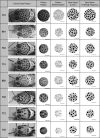Isolating and quantifying the role of developmental noise in generating phenotypic variation
- PMID: 31009449
- PMCID: PMC6497311
- DOI: 10.1371/journal.pcbi.1006943
Isolating and quantifying the role of developmental noise in generating phenotypic variation
Abstract
Genotypic variation, environmental variation, and their interaction may produce variation in the developmental process and cause phenotypic differences among individuals. Developmental noise, which arises during development from stochasticity in cellular and molecular processes when genotype and environment are fixed, also contributes to phenotypic variation. While evolutionary biology has long focused on teasing apart the relative contribution of genes and environment to phenotypic variation, our understanding of the role of developmental noise has lagged due to technical difficulties in directly measuring the contribution of developmental noise. The influence of developmental noise is likely underestimated in studies of phenotypic variation due to intrinsic mechanisms within organisms that stabilize phenotypes and decrease variation. Since we are just beginning to appreciate the extent to which phenotypic variation due to stochasticity is potentially adaptive, the contribution of developmental noise to phenotypic variation must be separated and measured to fully understand its role in evolution. Here, we show that variation in the component of the developmental process corresponding to environmental and genetic factors (here treated together as a unit called the LALI-type) versus the contribution of developmental noise, can be distinguished for leopard gecko (Eublepharis macularius) head color patterns using mathematical simulations that model the role of random variation (corresponding to developmental noise) in patterning. Specifically, we modified the parameters of simulations corresponding to variation in the LALI-type to generate the full range of phenotypic variation in color pattern seen on the heads of eight leopard geckos. We observed that over the range of these parameters, variation in color pattern due to LALI-type variation exceeds that due to developmental noise in the studied gecko cohort. However, the effect of developmental noise on patterning is also substantial. Our approach addresses one of the major goals of evolutionary biology: to quantify the role of stochasticity in shaping phenotypic variation.
Conflict of interest statement
The authors have declared that no competing interests exist.
Figures












Similar articles
-
Mosaic physiology from developmental noise: within-organism physiological diversity as an alternative to phenotypic plasticity and phenotypic flexibility.J Exp Biol. 2014 Jan 1;217(Pt 1):35-45. doi: 10.1242/jeb.089698. J Exp Biol. 2014. PMID: 24353202 Review.
-
Iridophoroma associated with the Lemon Frost colour morph of the leopard gecko (Eublepharis macularius).Sci Rep. 2020 Mar 31;10(1):5734. doi: 10.1038/s41598-020-62828-9. Sci Rep. 2020. PMID: 32235892 Free PMC article.
-
The role of post-natal ontogeny in the evolution of phenotypic diversity in Podarcis lizards.J Evol Biol. 2011 Dec;24(12):2705-20. doi: 10.1111/j.1420-9101.2011.02396.x. Epub 2011 Sep 29. J Evol Biol. 2011. PMID: 21954968
-
The other side of phenotypic plasticity: a developmental system that generates an invariant phenotype despite environmental variation.J Biosci. 2009 Oct;34(4):543-51. doi: 10.1007/s12038-009-0073-8. J Biosci. 2009. PMID: 19920340 Review.
-
Genetics, development and evolution of adaptive pigmentation in vertebrates.Heredity (Edinb). 2006 Sep;97(3):222-34. doi: 10.1038/sj.hdy.6800861. Epub 2006 Jul 5. Heredity (Edinb). 2006. PMID: 16823403 Review.
Cited by
-
The revised reference genome of the leopard gecko ( Eublepharis macularius ) provides insight into the considerations of genome phasing and assembly.bioRxiv [Preprint]. 2023 Feb 13:2023.01.20.523807. doi: 10.1101/2023.01.20.523807. bioRxiv. 2023. Update in: J Hered. 2023 Aug 23;114(5):513-520. doi: 10.1093/jhered/esad016. PMID: 36712019 Free PMC article. Updated. Preprint.
-
A synthetic synthesis to explore animal evolution and development.Philos Trans R Soc Lond B Biol Sci. 2022 Jul 18;377(1855):20200517. doi: 10.1098/rstb.2020.0517. Epub 2022 May 30. Philos Trans R Soc Lond B Biol Sci. 2022. PMID: 35634925 Free PMC article. Review.
-
New approaches for capturing and estimating variation in complex animal color patterns from digital photographs: application to the Eastern Box Turtle (Terrapene carolina).PeerJ. 2025 Jul 21;13:e19690. doi: 10.7717/peerj.19690. eCollection 2025. PeerJ. 2025. PMID: 40708826 Free PMC article.
-
Melanistic coloration does not influence thermoregulation in the crepuscular gecko Eublepharis macularius.Biol Open. 2023 Oct 15;12(10):bio060114. doi: 10.1242/bio.060114. Epub 2023 Nov 2. Biol Open. 2023. PMID: 37756597 Free PMC article.
-
Environment-dependent selection impacts heritable developmental stability and trait canalization in rice.bioRxiv [Preprint]. 2025 Jun 16:2025.06.13.659410. doi: 10.1101/2025.06.13.659410. bioRxiv. 2025. PMID: 40667336 Free PMC article. Preprint.
References
Publication types
MeSH terms
LinkOut - more resources
Full Text Sources

